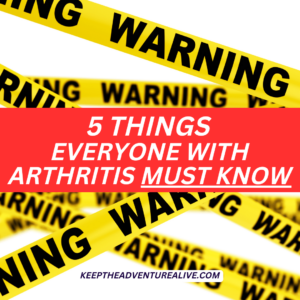The best exercises for stiff joints are simple but extremely effective. The more we move, the more we help our joints to clear out the inflammatory cells that cause arthritis stiffness. Exercises can be effective in the morning, after activity, or in the evening when stiffness commonly occurs. These exercises can be done in standing, sitting, or even lying down. Knee bends, straight leg raise, forward bends, and shoulder rotations are just to name a few. Gone are the days your joints feel like cement blocks, hello freedom with these exercises below!
Do your joints feel stiff after you’ve been sitting for a while?
Do you wake up and feel like your joints were swapped for cement blocks overnight?
Are you tired of hobbling around for the first few steps until your joints loosen up?
If you answered yes to any of these questions, keep reading.
When we have osteoarthritis, our cells aren’t as efficient at clearing out inflammation. Inflammatory cells love when we don’t move, especially when we are in one position for a long period of time. They nestle in and don’t allow for much room for movement when we go to get up, thus creating stiffness. So how do we get this inflammation out of there and decrease our stiffness?!
The bottom line is, we have to keep our joints moving and avoid staying in one position for a long period of time. The more we move our muscles the less stiffness we feel. This is because we increase our blood flow which helps recycle some of the “garbage” inflammatory cells and healthy cells are brought in as replacements.
But what if you have to sit at work, stand while cooking, or lay down for sleeping? We can’t always be moving and that is okay. We can easily find ways to improve the amount that we are moving during the day though. We want to avoid sitting, laying, or standing in the same position for longer than 30 minutes at a time.
For example, one of my clients was dealing with low back stiffness that would turn into spasms spontaneously throughout his work day. He never felt comfortable and was always afraid of when the next spasm was going to occur. We added in just a few simple exercises like I am going to show you below and now his back doesn’t even cross his mind during the day! He knows exactly what he needs to do to take care of it.
These are some of the BEST exercises for stiff joints and once you begin working them into your routine, I know your joints will love them.
1. Standing Exercises
Trying small movements while you are sitting, standing, or lying down can make a huge difference on the stiffness you feel when you go to move. If you find you are hobbling for a few steps every time you get up, try these exercises below.
The good news? Making just a few simple changes to your routine can make an immense difference to the joint stiffness you feel. If you have a hard time remembering to move, many of my clients find setting an alarm every 20-30 minutes very helpful.
If your knees tend to get stiff when you are cooking, cleaning, or standing for a long period of time take a look. Bending and straightening your knee a few times every hour can make a huge difference. If you would like to know the TOP 3 Myths related to knee pain that you need to overcome in order to keep your adventure alive, check out the FREE guide here.
If your low back or knees tend to feel tight after standing for a long period of time, try this below. Alternating marching can help relieve stiff joints. Exercise can be one of the best ways to combat low back stiffness and pain. This is because we are making our muscles contract and thus relax in a more lengthened state.
Complete for 30-60 seconds, every hour for optimum relief.
If you are experiencing hip stiffness, completing these lateral kicks can help to activate other muscles that don’t tend to get used as often as they should. Move in a range that is most comfortable to you!
Complete 15+ reps on each side or until the leg you are standing on becomes fatigued for optimum relief.
2. Sitting Exercises:
If you are experiencing knee or hip joint stiffness after sitting for a long period of time, try this simple exercise routine below. These are some of the best exercises for stiff joints when sitting. The idea is to increase blood flow by using your muscles and moving your joints. When we stay in one position, blood tends to pool and inflammation nestles in. If we keep moving, we can negate much of this stiffness!
Complete each exercise for 10-15 reps for optimum results.
If you are experiencing neck or upper back stiffness from sitting and looking at a phone, tv, or book try these exercises below! These are isometric exercises, which mean you are contracting your muscles without actually moving. These are some of the best exercises for joint stiffness because they help with pain relief and can improve mobility. A contoured pillow may also help keep your neck in a better supported position if you notice pain while you are sleeping.
3. Exercises when laying down:
Do you ever notice that joint stiffness is at it’s worst in the morning? This is because most of the time when we are sleeping, we aren’t doing much moving. Thus, inflammation sets in and our joints become harder to move.
Add in some simple movements before you get out of bed is most ideal when trying to work out the stiffness. It’s not always manageable, especially when you are in a rush or have to get to the bathroom quickly. But on days that you have some time, these are the best exercises for joint stiffness so you don’t have to hobble around your room!
These exercises below are separated by specific joint:
Knee Exercises
If you have knee stiffness follow this routine below to improve blood flow and wake your muscles up before taking on the day. During the day, a neoprene knee sleeve may also help fend off swelling and keep your joints happy!
Low back exercises
If you have Low back stiffness, these exercises are great to relieve pain so you can get on with your day. A heating pad may also offer more pain relief to help you relax if you notice excessive stiffness.
Shoulder exercises
If you have shoulder stiffness that complicates your morning routine. These exercises to help reduce pain while getting dressed and completing other morning activities. You can also use a heating pad before you get out of bed or during the day to facilitate more relaxation in your muscles.
Why these are the best exercises for stiff joints:
These exercises don’t have to be rocket science. They are very simple, but the key is consistency! The longer you stay stagnant and immobile, the stiffer your joints become. Movement is vital to preventing further joint stiffness. If you can create a consistent routine out of these exercises above, you can have more confidence in your management of your stiff joints.
Tackling stiffness is one of the first steps towards keeping your adventure alive with arthritis. Stiffness can be limiting, especially in the morning but there are steps you can take to alleviate it. There were quite a few exercises listed above, but don’t worry, you don’t have to do all of them! Choose your favorite 2-3 exercises to do throughout the day.
You can absolutely manage your joint stiffness so your joints don’t constantly feel like cement blocks! Inflammation hates when we move and loves when we stay in one position. Create an environment that inflammation doesn’t want to hang out in to see the best results.
I would love it if you subscribed to my YouTube channel HERE to get updates on when I release new videos. The channel is full of videos with tips and tricks on how to manage different aspects of arthritis.
—————
Alyssa Kuhn is a doctor of physical therapy based in Sandy, Utah and an arthritis specialist. She has helped countless people around the country find joint pain relief while regaining adventure. She is on a mission to help you find hope within arthritis and get your life back while breaking free from the pain without pain pills or surgeries.
Disclaimer: This post is for general informational purposes only. It should not be used to self-diagnose and it is not a substitute for a medical exam, cure, treatment, diagnosis, and prescription or recommendation. It does not create a doctor-patient relationship between Dr. Kuhn and you. You should not make any change in your health regimen or diet before first consulting a physician and obtaining a medical exam, diagnosis, and recommendation. Move Well Age Well, LLC and Dr. Alyssa Kuhn, PT, DPT are not liable or responsible for any advice, course of treatment, diagnosis or any conclusions drawn, services or product you obtain through this video or site.




